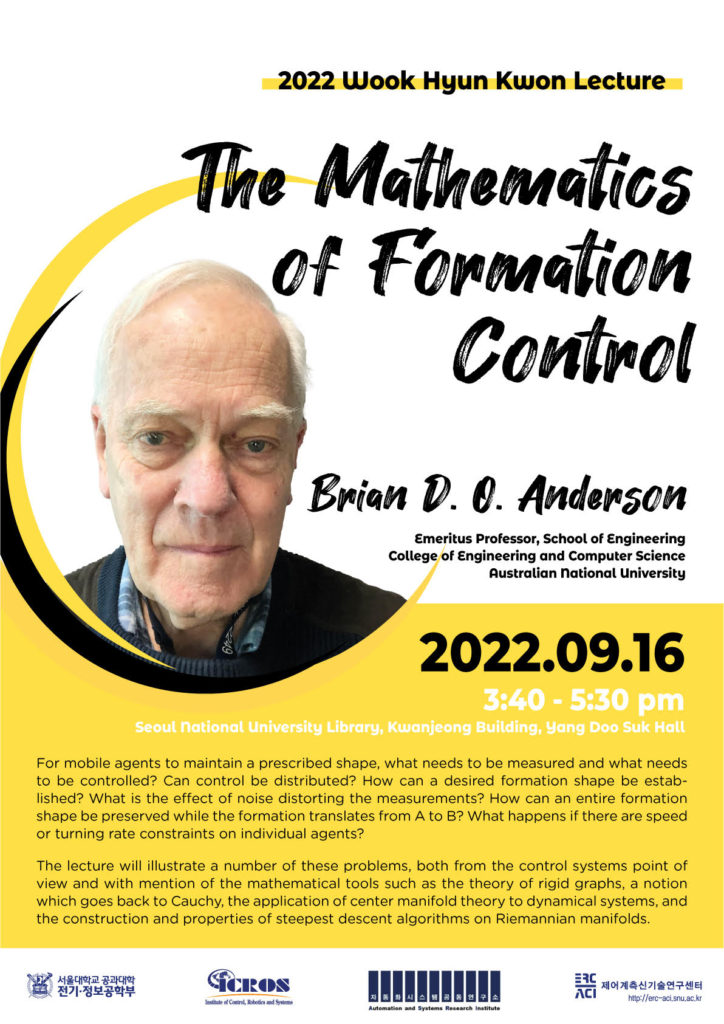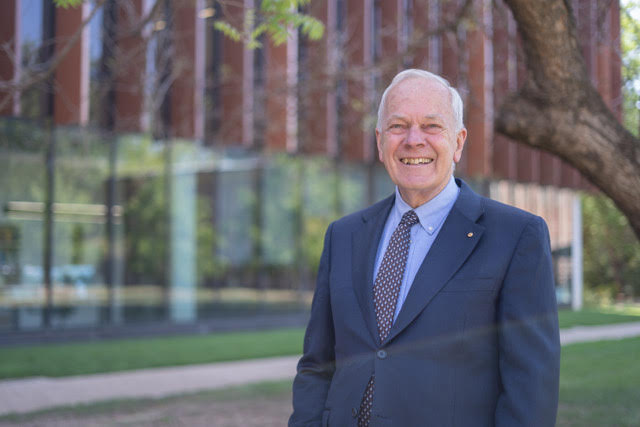Lecture: “The Mathematics of Formation Control” by Brian D. O. Anderson
Date & Time: September 16 (Friday), 2022, 3:40 PM ~ 5:30 PM
Place: Seoul National University Library, Kwanjeong Building, Yang Doo Suk Hall
Formations of mobile agents, including unmanned airborne vehicles, are examples of distributed systems. They may often be used to localize objects in the environment, and many control problems arise. For example, often, such formations should take up a particular shape. What needs to be measured and what needs to be controlled to maintain a prescribed shape? Can control be distributed, i.e. can one arrange for each agent just to observe its neighbors and act appropriately, and yet have the whole formation behave correctly? How can a desired formation shape be established? What is the effect of noise distorting the measurements? How can an entire formation shape be preserved while the formation translates from A to B? What happens if there are speed or turning rate constraints on individual agents?
The resolution of these questions draws ideas from diverse mathematical subfields, including subfields which do not necessarily feature strongly in the control engineer’s toolbox. One of these is graph theory, especially the theory of rigid graphs, a notion which goes back to Cauchy, but requires generalization to cope with directed graphs, and still has significant gaps in the relevant theory. Other relevant mathematical subfields include the application of center manifold theory to dynamical systems, and the construction and properties of steepest descent algorithms on Riemannian manifolds. The lecture will illustrate a number of these problems, both from the control systems point of view and with mention of the mathematical tools involved in addressing them.

Tutorial lecture: Rigidity
Date & Time: September 17 (Saturday), 2022, 9:30 AM ~ 12:30 PM
Place: Seoul National University Library, Kwanjeong Building, Yang Doo Suk Hall
The notion of rigidity underpins many algorithms for the control of formation shapes, and separately, is crucial to the understanding of sensor network localization, and related localization problems. This lecture provides a tutorial on the subject of rigidity.
The study of rigidity arises from basic questions such as what structures comprised of bars or beams linked at joints are rigid—when the structures are two or three dimensional.
Rigidity can be checked algebraically, and also, in the case of two-dimensional structures, by a counting algorithm focussing on the bars and joints but which takes no account of the lengths of the bars. In this lecture, we will consider a number of key aspects, for example, how rigid structures can be added to, while preserving rigidity, how rigid structures can be linked, with the linked structure rigid, and to what extent knowledge of the length of the bars in a rigid structure determines the actual shape of the structure. Other issues include securing redundancy, handling removal (failure) of a bar or a joint, and the modifications to the concept needed when rigid bars are replaced by control laws which maintain a fixed spacing between two points.
2022 Lecturer: Prof. Brian D O Anderson

- Undergraduate degrees in Mathematics and Electrical Engineering at Sydney University
- Doctoral degree in Electrical Engineering at Stanford University.
- Professor of Electrical Engineering at the University of Newcastle, Australia from 1967 through 1981.
- Professor and Head of the Department of Systems Engineering at the Australian National University in Canberra, 1982 to 1991.
- Distinguished Professor from 1990 to 2016
- Director of the Research School of Information Sciences and Engineering from 1994 to 2002.
- Inaugural CEO of the newly formed National ICT Australia from May 2002 to May 2003.
- Chief Scientist of NICTA, From May 2003 to June 2006.
- Emeritus Professor from 2016.
- He has held many visiting appointments in the United States, Europe and Asia, including the University of California, Berkeley, Stanford University, Yale University, Swiss Federal Institute of Technology, Kyoto University and Tokyo Institute of Technology.
Professor Anderson has served as a member of a number of government bodies, including the Australian Science and Technology Council and the Prime Minister’s Science, Engineering and Innovation Council. He was a member of the Board of Cochlear Limited, the world’s major supplier of cochlear implants, from 1995 to 2005. He is a Fellow of the Australian Academy of Science and Academy of Technological Sciences and Engineering, the Institute of Electrical and Electronic Engineers, and an Honorary Fellow of the Institution of Engineers, Australia. In 1989, he became a Fellow of the Royal Society, London, and in 2002 a Foreign Member of the US National Academy of Engineering. He holds honorary doctorates of the Catholic University of Louvain in Belgium, the Swiss Federal Institute of Technology, and five Australian Universities He was appointed an Officer of the Order of Australia in 1993, and made a Companion in 2016. He received the Japanese Order of the Rising Sun with Neck Ribbon and Gold Rays in 2007.
He was President of the International Federation of Automatic Control for the triennium 1990 to 1993, and served as President of the Australian Academy of Science for four years from 1998 to 2002.
Honor and awards:
- Fulbright Grant, 1964, 1970, 1977
- Senior Prize for Best Paper, IEEE Trans on Acoustics, Speech and Signal Processing, 1986
- Kelvin Premium, IEE, 1989, Electrical College Eminent Speaker 1990-1991
- DHC (Docteur honoris causa), Université Catholique de Louvain, 1991
- Flinders Lectureship and Medal, Australian Academy of Science, 1992
- Guillemin-Cauer Award, IEEE Circuits and Systems Society, 1992
- IEEE Control Systems Society Bode Prize, 1992
- Officer of Order of Australia, 1993
- Dr sc tech hc (Doctor honoris causa), ETH (Swiss Federal Institute of Technology), Zürich 1993
- Vice-Chancellor’s Award for Excellence in Teaching, The Australian National University, 1994
- International Award of Society for Materials Engineering for Resources of Japan, 1994
- Hon DEng, University of Sydney, 1995
- Life Adviser, International Federation of Automatic Control, 1996
- IEEE Control Systems Award, 1997
- Hon DEng, University of Melbourne, 1997
- Guest of Honour, World Automation Congress (WAC’98), Alaska, USA, 1998
- Quazza Medal, IFAC, 1999
- Best Paper Prize, Automatica, 1999
- Named by ISI as one of the most highly cited scientists in the world within the category of engineering for the period 1981-1999
- Honorary Professor, Harbin Institute of Technology, China, 2000
- Hon DSc, University of New South Wales, 2001
- Distinguished Lecturer, IEEE Control Systems Society, 2001
- IEEE James H Mulligan Jr Education Medal, 2001
- Guillemin-Cauer Award, IEEE Circuits and Systems Society, 2001
- MA Sargent Medal, Institute of Engineers, Australia, 2002
- Asian Control Professors Association Education Award, 2002
- Centenary Medal, Government of Australia, 2003
- Chancellor’s Special Commendation and Medal, The Australian National University, 2004
- Hon DEng, University of Newcastle, 2005
- Commendation of Foreign Minister of Japan, 2006
- Order of the Rising Sun with Neck Rays and Gold Ribbon (Japan) 2007
- Best Paper Prize, Asian Journal of Control, 2009
- Hon DEng, University of Technology Sydney, 2012
- Best Paper Prize (Guan Zhao-Zhi Award), Chinese Control Conference, 2015
- Companion of the Order of Australia, 2016
- John R. Ragazzini Education Award, American Automatic Control Council, 2016
- Honorary Professor, Zhejiang University, China, 2016
- Honorary Professor, Shandong University, China, 2018
- Gdansk University of Technology Medal, 2018
- Peter Nicol Russell Medal, Engineers Australia, 2019
